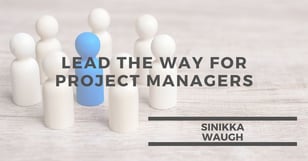Influence, Change, Purpose
One of the most common questions I get when I’m teaching our 1-day or 2-day Project Management classes takes various forms, but essentially translates to something like this: “How do I get other people to stay engaged in the project, even when they don’t feel like it?” It’s a great question that can apply to so much more than projects! How do I get my colleagues to stay engaged at work, even when it’s great golfing weather outside. How do I get my leader to continue to support that pet project of mine, even when she’s got other things on her plate? How do I get my kids to keep up their chores even in the lazy days of summer? You get the idea…
Let me offer three techniques I’ve found useful over the years.
1 - Personal Influence:
Influence is your ability to make someone else want to do something. Power is your ability to make them do something, but influence doesn’t require power. Influence is when the other person wants to do the thing you want them to do. In order to do that, you have to know what motivates them, to use their “currency” if you will. This is less about the task, the project, or the work, and more about your understanding of who they are and your willingness to adjust the situation to maximize their engagement.
- Is it someone who likes the thrill of winning? Make a competition out of it.
- Is it someone who likes to collaborate and chat together? Make some portion of the task collaborative in nature and give them a chance to chat.
- Is it someone who likes to be recognized for their expertise? Recognize them and appreciate them - out loud - for their contributions.
2 - Change Leadership:
Helping someone through the journey of change is really very simple - it’s not easy, but it’s simple. It involves an understanding of the basic journey of change, a commitment to effective communication, and a way to connect with and educate the other person. One really important piece is to make sure your messaging is relevant to them in the moment they find themselves. If your message doesn’t align with their moment, it won’t help them stay engaged.
- Before the change happens, spend some time making sure you understand where they’re coming from, how they feel about change in general, how hungry they are for this particular change, and what their concerns are as well as what they’re looking forward to. Make sure you’re aware of the common ground you share with them, too! To the greatest extent possible, help them see that where they’re headed is even better than where they are today.
- When they have to let go of something they’ve appreciated, spend some time listening to them. Hear them out. Listen to their feelings and their expressions of loss, sorrow, grief, or frustration. Show empathy. Be kind. Be patient.
- When they are between the old and the new, and highly uncomfortable with the gray of uncertainty, help them find solid footing. Remind them of the vision for the future, and help them know that they are not alone.
- When they are expressing exhaustion about the heavy lifting of the changes taking place, encourage them, offer them ways to take a quick break or rest a little, and let them know you’re here to support and encourage them.
- When they have arrived at whatever the new space is, celebrate them for how far they’ve come and how hard they’ve worked, and enjoy the new space together.
3 - The Why:
Starting with the why aligns us on the same page. Simon Sinek has spoken and written for years about how powerful a common “why” can be to draw people around us and unlock their loyalty. Just yesterday, I heard someone put it this way, “They’ll only follow you off the map if they trust you on the map.” I think what the person was getting at is that if I can trust that we have a common purpose, I can trust you enough to follow you or stick with you when you vary from what I might have done.
- The why behind your project may make a good motivator - make sure you’ve articulated it clearly and posted it visibly.
- The why behind your business or company or team can make an excellent way to draw people together - make sure that employees, customers, vendors, and business partners all understand that why in no uncertain terms.
- The why behind a particular role, task, project, or event can make even tough experiences more palatable - make sure that you’ve led with why you’re asking them to do the thing at hand.
- The why behind you, your personal mission, can be a huge draw to inspire others - make sure you’re consistent in your articulation of why you do what you do.
If you’re interested in learning more, each of these concepts comes up in our upcoming 6-part virtual coaching program called Lead the Way for Project Managers. Tailored specifically for those with influence but limited authority, this session helps you in your people-leadership skills, even if the folks you lead have a dotted-line (or non-existent line) reporting relationship.
How about you, how have you applied these three ideas, and have they helped you help others stay engaged? I’d love to hear your successes!









